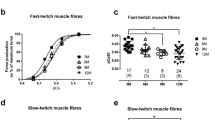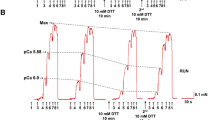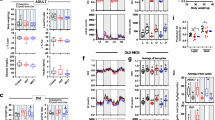Summary
The effects of ageing and life-long endurance training on the collagen metabolism of skeletal muscle were evaluated in a longitudinal study. Wistar rats performed treadmill running 5 days a week for 2 years. The activities of collagen biosynthesis enzymes, prolyl-4-hydroxylase and galactosylhydroxylysyl glucosyltransferase, were highest in the muscles of the youngest animals, decreased up to the age of 2 months and from then on remained virtually unchanged. The enzyme activity in young animals was higher in the slow collagenous soleus muscle than in the rectus femoris muscle. The enzyme activity in the soleus muscle was higher for older trained rats than older untrained rats. The relative proportion of type I collagen increased and that of type III collagen decreased with age, suggesting a more marked contribution by type I collagen to the agerelated accumulation of total muscular collagen. The results show that collagen biosynthesis decreases with maturation and that life-long endurance training maintains a higher level of biosynthesis in slow muscles.
Similar content being viewed by others
References
Alnageeb MA, Zaid NS, Goldspink G (1984) Connective tissue changes and physical properties of developing and ageing skeletal muscle. J Anat 139:677–689
Anttinen H, Oikarinen A, Kivirikko KI (1977) Age-related changes in human skin collagen galactosyltransferase and collagen glucosyltransferase activities. Clin Chim Acta 76:95–101
Anttinen H, Järvensivu PH, Sovalainen E-R (1981) Serum galactosylhydroxylysyl glucosyltransferase in acute myocardial infarction and during subsequent collagen scar formation. Eur J Clin Invest 11:375–379
Anttinen H, Terho EO, Järvensivu PM, Savolainen E-R (1985) Elevated serum galactosylhydroxylysyl glucosyltransferase, a collagen synthesis marker, in fibrosing lung diseases. Clin Chim Acta 3:3–8
Berg RA, Prockop DJ (1973) The thermal transition of a nonhydroxylated form of collagen. Evidence for a role for hydroxyproline in stabilizing the triplehelix of collagen. Biochem Biophys Res Commun 52:115–119
Booth FW, Gould EW (1975) Effects of training and disuse on connective tissue. In: Willmore JH, Keogh JF (eds) Exercise and sport sciences reviews. Academic Press, New York, p 83–112
Borg TK, Caulfield JB (1980) Morphology of connective tissue in skeletal muscle. Tissue Cell 12:197–207
Bornstein P, Sage H (1980) Structurally distinct collagen types. Annu Rev Biochem 49:957–1003
Duance VC, Restall DJ, Beard H, Bourne FJ, Bailey AJ (1977) The location of three collagen types in skeletal muscle. FEBS Lett 79:248–252
Epstein EH (1974) (α 1 (III))3 Human skin collagen release by pepsin digestion and preponderance in fetal life. J Biol Chem 249:3225–3231
Gutmann E (1977) Muscle. In: Finch CE, Hayflick L (eds) Handbook of the biology of ageing. Van Nostrand, New York, pp 445–469
Hasselbach W, Schneider G (1951) Der L-Myosin-und Aktin-gehalt des Kaninchenmuskels. Biochem Z 321:462–475
Juva K, Prockop DJ (1966) Modified procedure for the assay of H3- or C14-labelled hydroxyproline. Anal Biochem 15:77–83
Kivirikko KI, Myllylä R (1979) Collagen glycosyltransferases. Int Rev Connect Tissue Res 8:23–72
Kivirikko KI, Myllylä R (1980) The hydroxylation of prolyl and lysyl residues. In: Freedman RB, Hawkins HC (eds) The enzymology of posttranslational modifications of proteins. Academic Press, London, pp 53–104
Kivirikko KJ, Myllylä R (1982) Posttranslational enzymes in the biosynthesis of collagen: intracellular enzymes. In: Colowick SP, Kaplan NO (eds) Methods in enzymology, vol 82. Structural and contractile proteins. Academic Press, New York, pp 245–304
Kivirikko KI, Laitinen D, Prockop DJ (1967) Modification of a specific assay for hydroxyproline in urine. Anal Biochem 19:249–255
Kovanen V, Suominen H (1987) Effects of age and lifetime physical training on fibre composition of slow and fast skeletal muscle in rats. Pflügers Arch 408:543–551
Kovanen V, Suominen H, Heikkinen E (1980) Connective tissue of “fast” and “slow” skeletal muscle in rats — effects of endurance training. Acta Physiol Scand 108:173–180
Kovanen V, Suominen H, Heikkinen E (1984a) Collagen of slow twitch and fast twitch muscle fibres in different types of rat skeletal muscle. Eur J Appl Physiol 52:235–242
Kovanen V, Suominen H, Heikkinen E (1984b) Mechanical properties of fast and slow skeletal muscle with special reference to collagen and endurance training. J Biomech 17:725–735
Kovanen V, Suominen H, Peltonen L (1987) Effects of aging and life-long physical training on collagen in slow and fast skeletal muscle in rats. A morphometric and immunohistochemical study. Cell Tissue Res 248:247–255
Kuutti-Savolainen E-R, Anttinen H, Miettinen TA, Kivirikko KI (1979) Collagen biosynthesis enzymes in serum and hepatic tissue in liver disease. II. Galactosylhydroxylysyl glucosyltransferase. Eur J Clin Invest 9:97–101
Laemmli VK (1970) Cleavage of structural proteins during the assembly of the head of bacteriophage T4. Nature 227:680–685
Laurent GJ (1987) Dynamic state of collagen: pathways of collagen degradation in vivo and their possible role in regulation of collagen mass. Am J Physiol 252:C1-C9
Laurent JL, Cockerill P, McAnulty RJ, Hastings JRB (1981) A simplified method for quantitation of the relative amounts of type I and type III collagen in small tissue samples. Anal Biochem 13:301–312
Lento M (1983) Collagen and fibronectin in a healing skeletal muscle injury: an experimental study in rats under variable states of physical activity. Ann Univ Turk Ser D Med-Odontol
Light ND (1982) Estimation of types I and III collagens in whole tissue by quantitation of CNBr peptides on SDSpolyacrylamide gels. Biochim Biophys Acta 702:30–36
Light ND, Bailey AJ (1979) Covalent crosslinks in collagen: characterization and relationships to connective tissue disorders. In: Parry DAS, Creamer LK (eds) Fibrous proteins: scientific, industrial and medical aspects. Academic Press, London, pp 151–177
Mayne R, Sandersen RD (1985) The extracellular matrix of skeletal muscle. Coll Relat Res 5:449–468
Myllylä R, Myllylä W, Tolonen V, Kivirikko KI (1982) Changes in collagen metabolism in diseased muscle. I. Biochemical studies. Arch Neurol 39:752–755
Peltonen L, Myllylä R, Tolonen V (1983) Changes in collagen metabolism in diseased muscle. II. Immunohistochemical studies. Arch Neurol 39:756–759
Ramshaw JAM (1986) Distribution of type III collagen in bovine skin of various ages. Connect Tissue Res 14:307–314
Savolainen ER, Miettinen TA, Pikkarainen P, Salaspuro MP, Kivirikko KI (1983) Enzymes of collagen synthesis and type III procollagen aminopropeptide in the evaluation of D-penicillamine and medroxyprogesterone treatments of primary biliary cirrhosis. Gut 24:136–142
Suominen H, Heikkinen E (1975) Enzyme activities in muscle and connective tissue of M. vastus lateralis in habitually training and sedentary 33 to 70-year-old men. Eur J Appl Physiol 34:249–254
Suominen H, Heikkinen E, Parkatti T (1977) Effect of eight weeks' physical training on muscle and connective tissue of the m. vastus lateralis in 60-year-old men and women. J Gerontol 32:33–37
Takala TES, Myllylä R, Salminen A, Anttinen H, Vihko V (1983) Increased activities of prolyl-4-hydroxylase and galactosylhydroxylysyl glucosyltransferase, enzymes of collagen biosynthesis in skeletal muscle of endurance-trained mice. Pflügers Arch 399:271–274
Tryggvason K, Majamaa K, Kivirikko KI (1979) Prolyl 3-hydroxylase and 4-hydroxylase activities in certain rat and chick-embryo tissues and age-related changes in their activities in the rat. Biochem J 178:127–131
Tuderman L, Kivirikko KI (1977) Immunoreactive prolyl hydroxylase in human skin, serum and synovial fluid: changes in the content and components with age. Eur J Clin Invest 7:295–299
Vogel HG (1974) Correlation between tensile strength and collagen content in rat skin effect of age and cortisol treatment. Connect Tissue Res 2:177–182
Author information
Authors and Affiliations
Rights and permissions
About this article
Cite this article
Kovanen, V., Suominen, H. Age- and training-related changes in the collagen metabolism of rat skeletal muscle. Europ. J. Appl. Physiol. 58, 765–771 (1989). https://doi.org/10.1007/BF00637389
Accepted:
Issue Date:
DOI: https://doi.org/10.1007/BF00637389




